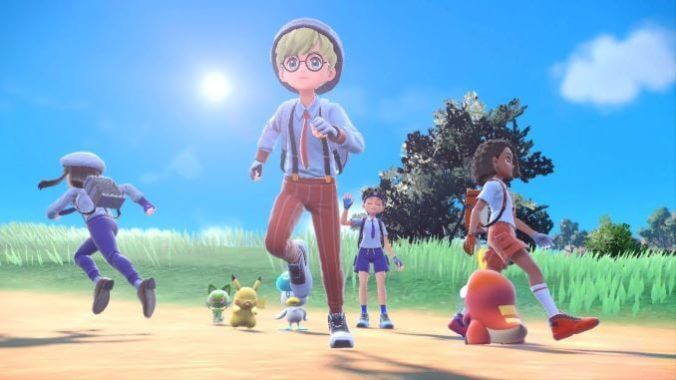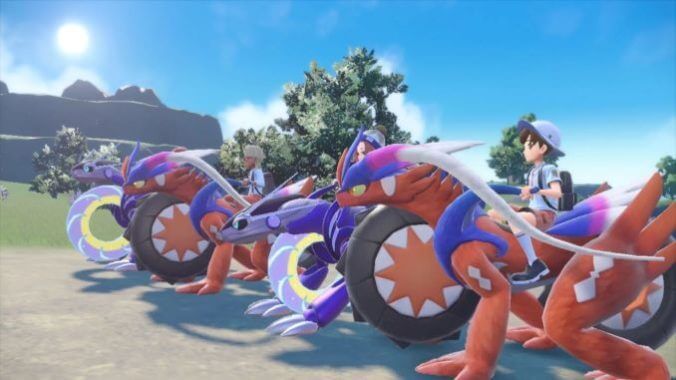Imagine you’re at a drag race. Let’s say nine or so cars border the starting line. The starting gun fires and they’re off! One car’s parachute opens up immediately. Unable to look away from the unfolding chaotic failure, your gaze is locked on this red and purple automobile as it miraculously tears down the track, passing nearly every other participant. It doesn’t finish first, but it does clear a shockingly close third. Pokémon Scarlet and Violet are this dysfunctional underdog.
Although it’s held back by both groveling reverence to tradition and a bounty of technical issues, this pair defies towering odds to achieve more than most Pokémon games period. Warts and all, the ninth generation of Pokémon represents Game Freak, the Pokémon Company and their collaborators in near-peak form. Stellar monster designs, heartfelt storylines, memorable characters, well-placed doses of challenge and freedom, a spectacular score and smart innovations demanded my attention more than its myriad of bugs, unsightly visuals or performance issues ever did.
At the time of writing, Pokémon Scarlet and Violet are coming off of a thorough public flogging. And rightfully so; Pokémon is famously the most popular entertainment franchise in the world. Both fan and critical outcry hit such a fever pitch after Scarlet and Violet released that even buttoned-down, quiet Nintendo came out with an apology, promising that fixes for their worst bugs were on the way. Sword and Shield and Legends: Arceus were also technically challenged—chugging and visually underwhelming, though still playable. Scarlet and Violet, on the other hand, are the most egregious entries in the series to date when it comes to bugs.
Even as one of the “lucky” ones whose playthrough was relatively glitch- and crash-free, I was astounded by how poorly this game ran. Out of my nearly 200 Switch games, these ran the worst—even compared to games designed for more powerful hardware like Wolfenstein II or DOOM (2016). The most common performance issue I encountered was framerate drops, but in all, the performance issues and bugs in this game run the gambit. Characters will pop in and out of frame at random, collision bugs might keep your character from landing on the ground after a jump, items might despawn, bosses might not let you interact with them, Pokémon might clip through the world in a battle, and textures on the walls twist and shift in a psychedelic manner.
Whether I was laughing with a friend’s flashback to a bygone trip or at a Pokémon just exiting its digital plane of existence, most of these bugs elicited a laugh and nothing more. Some bugs, namely the framerate and magically vanishing monsters (among others), did negatively impact my experience. Sometimes I felt motion sick from the choppy framerate and shifting textures ganging up on my eyes. Other times I couldn’t catch a rare Pokémon because it just up and left.
Despite these deep-rooted technical issues, Scarlet and Violet are excellent Pokémon games. Even their weak points have some merit. Just as it did in Kanto nearly 30 years ago, starting out your adventure in Paldea means choosing between three adorable creatures, meeting a rival trainer and a professor in a small town. But as events unfold, more and more signs point to this game being special. Quality of life improvements and a dazzling soundtrack show up first. Then the game’s stakes and goals make themselves known before all of this Spain-inspired region open up for you to explore. All along the way creative new Pokémon dot your path to be the very best.

In courting a true open-world structure, Scarlet and Violet tackle the repetitive nature of contemporary open-world games, mostly through the player having to find and conquer enemy outposts. Pokémon’s always had a repetitive nature to it; any given Pokémon game tasks players with taking on gyms and scrapping with a shady organization, but none have made each encounter feel quite so monotonous. The game successfully puts up a screen of smoke and mirrors by making each encounter as memorable as it can be thanks to ripping tracks, well-written characters and attention-grabbing story beats. But like many other open-world games, many of Scarlet and Violet’s encounters wind up boiling down to a very simple, repetitive formula.
The standout among the game’s three main storylines is easily the quest that sees players assist a new friend in finding some mythical herbs that supposedly make those who eat it stronger. It unfolds into a tender story with memorable (though again, repetitive) encounters. Some even help tease out the end of the game, where the three main storylines weave into each other for a fun conclusion.
Everything else is exactly as it was in other Pokémon games: fire beats grass, grass beats water and water beats fire, there are eight gyms, you can only carry six Pokémon with you at any given time, and on and on. In this regard, it feels lackluster compared to the (relatively) daring Legends: Arceus. Because of the ways you could interact with wild Pokémon in Arceus, its world felt more alive, even if they weren’t as well-designed as Scarlet and Violet’s. Because wild Pokémon in Scarlet and Violet are the key to its open world, even just some of Arceus’’ innovations would have gone a long way.
Although the open world felt repetitive to the point where I repeatedly got lost or confused in an area because the landscapes lacked any defining features or landmarks beyond a distant Pokémon Center, the allure of discovering new Pokemon pulled me across its open landscapes. In other open world games, it might’ve been the distant promise of a fascinating building or a new checkpoint on my map. In Scarlet and Violet, it’s a new Pokémon or a ridge just out of my reach. The amount of times I marveled at a new creature in the distance, mouth literally agape before just waltzing up and catching it brought me back to childhood. Discovery hasn’t felt this natural to me in an open-world game in years.
Alive or no, these games’ multiplayer offerings ratchet up that sense of childlike wonder even more: exploring a vast landscape and tackling tough raid battles lets you share that fun with a friend. Like with Nintendo’s other multiplayer games, it’s a pain to set up—and forget about voice chat—but it’s a great time with a buddy regardless.
Scarlet and Violet do many of the things I look for in a Pokémon game. From offering a diverse cast of catchable creatures to add to your team from the very beginning to emphasizing a more intimate story, this is a step in the right direction for Pokémon. If Game Freak had more time to sand off Scarlet and Violet’s myriad rough edges and flesh out some of its more repetitive portions, this would be the definitive entry in the Pokémon franchise.
The latest Pokémon games ship with tons of baggage. From visual shortcomings to a smattering of bugs, these games shouldn’t be as good as they are. Whether I was on the road or at a family gathering over a holiday weekend, I couldn’t put them down once I started playing thanks to Scarlet and Violet’s charming storylines, incredible monster designs, sonically rich soundtrack and enthralling battles. I haven’t had as much fun with a new Pokémon game in years, possibly even a decade, even if its launch sets a concerning precedent for the series going forward.
Pokémon Scarlet and Violet were developed by Game Freak and published by Nintendo and The Pokémon Company. They’re available for the Switch.
Charlie Wacholz is a freelance writer and college student. When he’s not playing the latest and greatest indie games, competing in Smash tournaments or working on a new cocktail recipe, you can find him on Twitter at @chas_mke.

